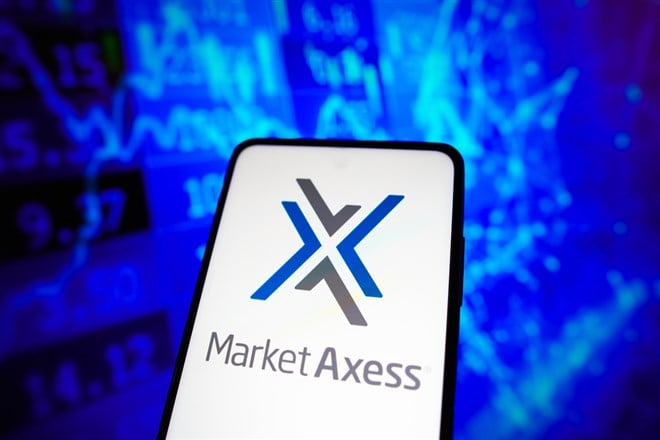
Bond-trading platform MarketAxess Holdings Inc. (NASDAQ: MKTX) has been on a roll lately, advancing at the following rates:
- 1 month: 2.96%
- 3 months: 26.12%
- Year-to-date: 30.89%
This is a stock in a seemingly unrelated industry that may stand to gain in the fallout from the failures of Silicon Valley Bank and Signature Bank.
Since early February, the stock has been forming a bullish consolidation area, correcting just 7% from peak to trough, with a potential buy point above $389.57. You can see that area of consolidation on this stock’s chart.
The stock is holding above its 50-day moving average, an indication that big institutional investors are holding shares as they anticipate a further move.
Nearing Possible Buy Point
On March 14, shares were trading less than 5% from a possible buy point.
In fact, according to MarketBeat data on MarketAxess, analysts currently have a “hold” rating on the stock.
New York-based MarketAxess has a market capitalization of $13.85 billion, putting it at the low end of what’s categorized as large-cap.
The company operates a platform for broker-dealers and other financial institutions can trade corporate fixed-income instruments. The bond market is much more fragmented than the stock market, and with instruments such as emerging-market bonds, traders can face liquidity issues.
MarketAxess’ platform can help streamline and speed up trading, offer lower costs, and more easily implement portfolio changes.
As you might imagine, MarketAxess operates globally, with offices in the Americas, Europe and the Asia Pacific region.
Record Average Daily Volume
In February, the company posted a record total credit average daily volume of $14.4 billion. In case you glossed over that number, that totals a whole lot of fixed-income instruments changing hands every business day. That was a 25% year-over-year increase.
In a statement, president and chief operating officer Chris Concannon noted that that number included 30% growth in high-grade instruments to a record $6.7 billion and 43% growth in high-yield to a record $2.3 billion.
“We believe that stronger industry volumes, estimated market share gains and a favorable macro backdrop, combined with stable average fees per million for total credit, are setting the stage for a strong 2023,” Concannon said.
The stock gapped up 4.15% on that news, on nearly double the average trading volume.
Analysts expect the company to earn $7.82 a share this year, an increase of 18%. That’s seen rising another 13% in 2024, to $8.87 a share.
Revenue Growth Rebounding
Revenue growth stagnated for four quarters in a row in 2021 and 2022, but began to rebound in the second quarter of last year. Revenue growth accelerated from 3% to 8% in the past two quarters.
Earnings growth resumed in the second quarter of last year, following several quarters in a row with year-over-year declines. The company has a long history of profitability, but earnings dropped in 2021.
The revenue decline in 2021 was due to lower volatility following the pandemic-era trading frenzy. Higher volatility equates to more trading, which equates to more fees generated. That was an industry-wide problem, as exchange operators such as Intercontinental Exchange Inc. (NYSE: ICE) saw some quarters of single-digit revenue growth in 2021 and 2022.
If bond prices rise in 2023, as many analysts predict, that could benefit MarketAxess as trading picks up.
MarketAxess is slated to report first-quarter results on or around April 26. Wall Street is looking for earnings of $1.95 per share on revenue of $201.54 million. Those would both be increases over the year-ago quarter.
More Institutional Buyers
The number of institutional owners has risen, which bodes well for the stock to make gains, or at least hold steady ahead of an earnings report, as it appears to be doing now.
However, there’s a bit of a twist, which is easy enough to understand: According to MarketBeat’s data on institutional ownership, in the past 12 months, 349 institutions accounted for $2 billion in inflows. However, 215 institutions accounted for $2.15 billion in outflows.
It’s fairly easy to deconstruct what happened: Shares declined 34% in 2022 as those institutions sold. A rally that got underway in October resulted in a 7.17% one-year return for MarketAxess. In other words, institutions were selling last year, but buying has resumed. It’s never a bad idea to follow the money when you see a rally generated by institutional dollars.






